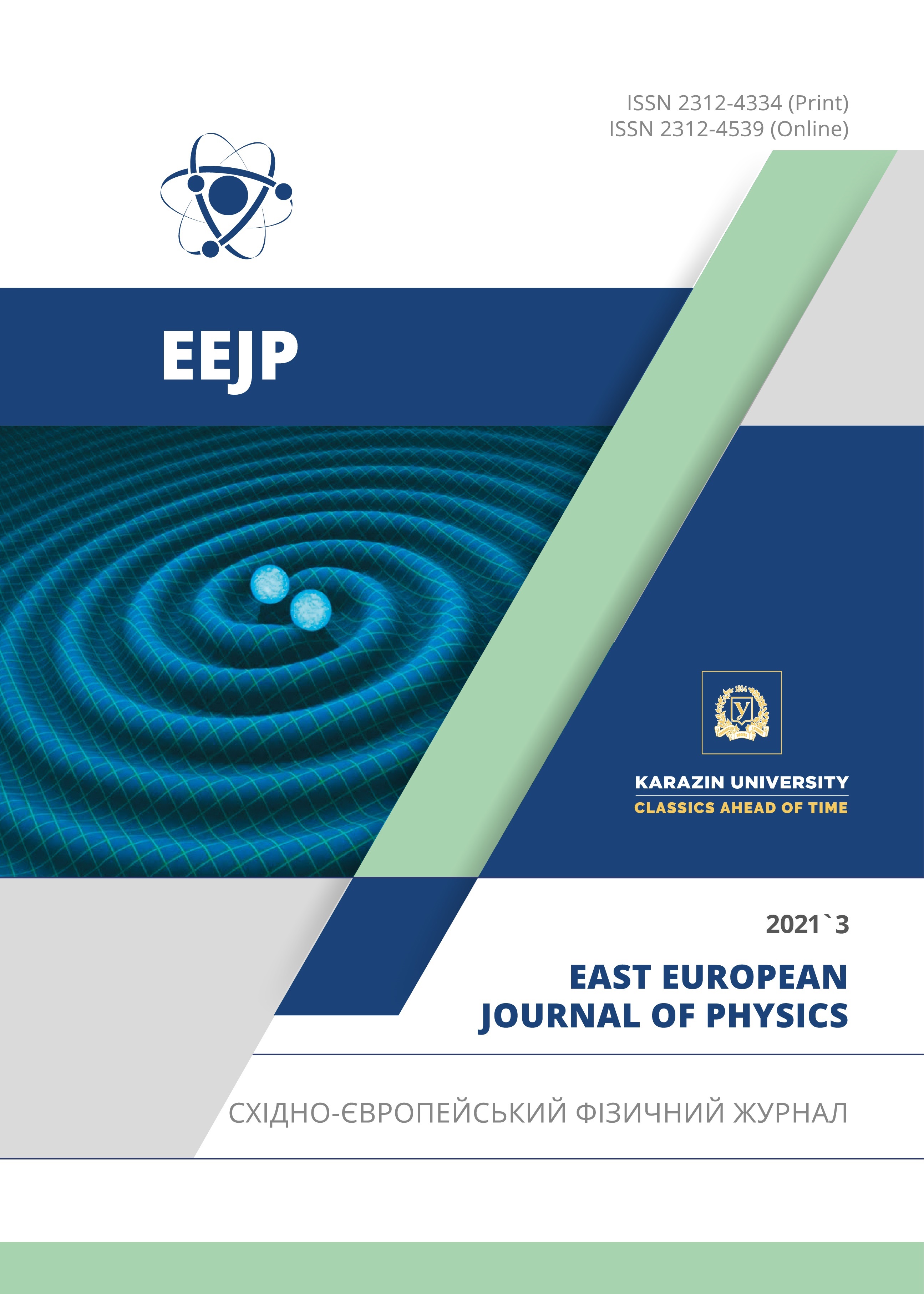Дослідження форми плями синхротронного випромінювання електронів-втікачів в моделі випромінювання спрямованого уздовж поверхні конуса їх швидкостей
Анотація
Електрони-втікачі – це фундаментальне фізичне явище, а токамак – найбільш просунута концепція магнітного утримання плазми. Енергія електронів-втікачів, які утворюються під час зривів розряду, може досягати десятків мегаелектронвольт, потрапляння яких на конструкційні елементи сучасних великих токамаків і споруджуваного міжнародного токамака-реактора ІТЕR може призвести до катастрофічних наслідків. Внаслідок актуальності, дане явище активно досліджується як теоретично, так і експериментально у провідних термоядерних центрах. Ефективний моніторинг електронів-втікачів є важливою задачею. Діагностика, що базується на синхротронному випромінюванні електронів-втікачів, дозволяє як безпосереднє їх спостереження, так і аналіз параметрів цих електронів, що сприяє безпечній роботі сучасних токамаків та майбутнього токамаку-реактора ITER. В 1990 році дана діагностика показала свою ефективність на токамаці TEXTOR для дослідження радіусу пучка, розташування, кількості та максимальної енергії електронів-втікачів. Ця діагностика встановлена на більшості сучасних токамаків. Параметр v┴/|v||| виявляє сильний вплив на поведінку синхротронного випромінювання електронів-втікачів (v|| - поздовжня, а v┴ - поперечна швидкість по відношенню до магнітного поля B). В статті теоретично вивчається форма плями синхротронного випромінювання електронів-втікачів, коли цей параметр не малий, що відповідає теперішнім експериментам на токамаках. Ураховані особливості руху релятивістського електрона в токамаці. Проаналізовано вплив розташування детектора на спостереження синхротронного випромінювання електронів – втікачів. Аналіз проведено у межах нелінійної моделі поверхні «конуса швидкостей». В цій моделі випромінювання ультрарелятивістських електронів спрямовано уздовж вектору їх швидкості v→, а вектор швидкості спрямовано уздовж поверхні конуса з віссю паралельній магнітному полю B. Раніше випадок малого параметру v┴/|v|| (v┴/|v|||<<1, лінійна модель) розглянуто в статті: Физика плазмы, 22, 588 (1996), ці теоретичні результати використовуються для аналізу експериментальних даних.
Завантаження
Посилання
B.N. Breizman, P. Aleynikov, E.M. Hollmann, and M. Lehnen, Nuclear Fusion, 59, 083001 (2019), https://doi.org/ 10.1088/1741-4326/ab1822
T.C. Hender, J.C. Wesley, J. Bialek, A. Bondeson, A.H. Boozer, R.J. Buttery, A. Garofalo, et al. Nuclear Fusion, 47, 128 (2007), https://doi.org/10.1088/0029-5515/47/6/S03
R. Jaspers, N.J. Lopes Cardozo, A.J.H. Donne, H.L.M. Widdershoven, and K.H. Finken, Review Sci. Instruments, 72-II, 466 (2001), https://doi.org/10.1063/1.1318245
K.H. Finken, J.G. Watkins, D. Rusbuldt, W.J. Corbett, K.H. Dippel, D.M. Goebel, and R.A. Moyer, Nuclear Fusion, 30, 859 (1990), https://doi.org/10.1088/0029-5515/30/5/005
I.M. Pankratov, Plasma Physics Reports, 22, 535 (1996), https://www.researchgate.net/profile/Igor-Pankratov/publication/252431545_Analysis_of_the_synchrotron_radiation_emitted_by_runaway_electrons/links/0deec52c98ac368d5c000000/Analysis-of-the-synchrotron-radiation-emitted-by-runaway-electrons.pdf
L.D. Landau, and E.M. Lifshitz, The classical theory of fields (Pergamon press).
M. Hoppe O. Embréus, R.A. Tinguely, R.S. Granetz, A. Stahl, and T. Fülöp, Nuclear Fusion 58, 026032 (2018), https://doi.org/10.1088/1741-4326/aa9abb
I.M. Pankratov, Plasma Physics Reports, 25, 145 (1999), https://inis.iaea.org/search/search.aspx?orig_q=RN:35003886
R.J. Zhou, I.M. Pankratov, L.Q. Hu, M. Xu, and J.H. Yang, Physics of Plasmas, 21, 063302 (2014), https://doi.org/10.1063/1.4881469
I. Entrop, R. Jaspers, N.J.L. Cardozo, and K.H. Finken, Plasma Physics and Controlled Fusion, 41, 377 (1999), https://doi.org/10.1088/0741-3335/41/3/004
J.H. Yu, E.M. Hollmann, N. Commaux, N.W. Eidietis, D.A. Humphreys, A.N. James, T.C. Jernigan, and R.A. Moyer, Physics of Plasmas, 20, 042113 (2013), https://doi.org/10.1063/1.4801738
C. Paz-Soldan, C.M. Cooper, P. Aleynikov, N.W. Eidietis, A. Lvovskiy, D.C. Pace, D.P. Brennan, E.M. Hollmann, C. Liu, R.A. Moyer, and D. Shiraki, Physics of Plasmas, 25, 056105 (2018), https://doi.org/10.1063/1.5024223
N.N. Bogoliubov, Y.A. Mitropolsky, Asymptotic methods in theory of non-linear oscillations (Gordon and Breach Science Publishers, 1961).
Автори, які публікуються у цьому журналі, погоджуються з наступними умовами:
- Автори залишають за собою право на авторство своєї роботи та передають журналу право першої публікації цієї роботи на умовах ліцензії Creative Commons Attribution License, котра дозволяє іншим особам вільно розповсюджувати опубліковану роботу з обов'язковим посиланням на авторів оригінальної роботи та першу публікацію роботи у цьому журналі.
- Автори мають право укладати самостійні додаткові угоди щодо неексклюзивного розповсюдження роботи у тому вигляді, в якому вона була опублікована цим журналом (наприклад, розміщувати роботу в електронному сховищі установи або публікувати у складі монографії), за умови збереження посилання на першу публікацію роботи у цьому журналі.
- Політика журналу дозволяє і заохочує розміщення авторами в мережі Інтернет (наприклад, у сховищах установ або на особистих веб-сайтах) рукопису роботи, як до подання цього рукопису до редакції, так і під час його редакційного опрацювання, оскільки це сприяє виникненню продуктивної наукової дискусії та позитивно позначається на оперативності та динаміці цитування опублікованої роботи (див. The Effect of Open Access).








